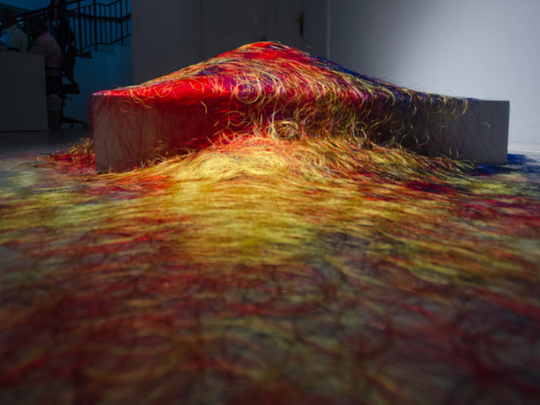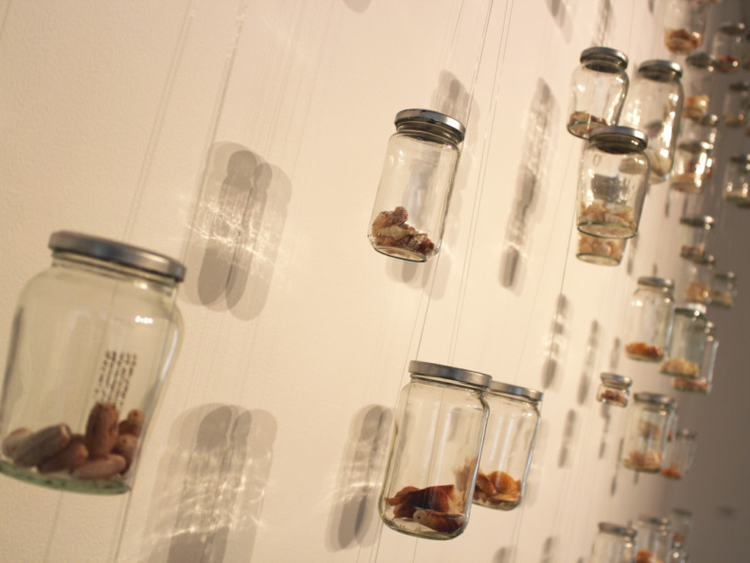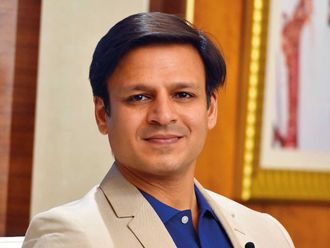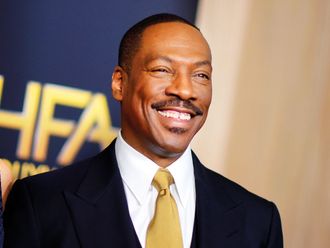
The latest exhibition at Tashkeel, “Sustaining Identity”, seeks to explore what sustainability means in the context of contemporary art. Earlier this year, Tashkeel invited UAE-based artists from all disciplines to submit original works depicting their interpretation of the theme within the context of their own practice.
The 17 artists whose pieces were selected for the show include Abir Mnasria and Zaina Khayyat, Afra Al Dhaheri, Alia Dawood, Bob Dahm, Collective W.I.N., Colleen Quigley, Fatima Al Budoor, Hasnat Mehmood, Jeff Scofield, Jonny Farrow, Karee S Dahl, Maitha Demithan, Naz Sharokh, Saher Oliver Samman, Tom Baggaley and Zlatan Filipovic.
Their works, which include paintings, photography, sculptures, installations, video and sound art, deal with the processes of collecting, archiving and documenting our changing environment and sustaining artistic practice in the UAE.
“This exhibition presents methods of sustainability which surround us daily as artists and how, through artistic practice, we can further our explorations and experimentations. Tashkeel aims to continue the consciousness of sustainability and identify our existence as an integral part of a sustainable city,” Tamsin Wildy, Tashkeel studio manager says.
The artists have used diverse techniques and materials to present their interpretations of the theme. Architect and artist Jeff Scofield’s installation, “The City by the Sea”, is composed of recycled glass jars of different sizes, filled with various types of sea shells, strung together with fishing line and hung on the wall, forming a skyline of buildings.
“I wanted to do something organic to express the contradictions of modern urban life. The sea shells and coral that I collected from Dubai Open Beach are the organic remains of an important part of the coastal ecosystem. The glass jars are also manufactured from natural materials such as sand and metal. This grid of jars represents the city by the sea, and in between I have left spaces for urban parks. The shadows on the wall look like people, and the flashes of light reflected on the wall could be seen as their souls. This work expresses the delicate coexistence between the city and the sea, and is a reminder that the preservation of the different species of life forms found in and around our cities and the ecosystems where they thrive is an integral part of a sustainable city,” Scofield says.
Abir Mnasria and Zaina Khayyat have also studied architecture and plan to establish their own art and design studio. Their joint project, “Herbarium”, presents different varieties of pressed wild plants collected from the desert, and solar prints of these plants on fabric.
“We have been living in Dubai for many years, but noticed these plants only recently, after we moved to an area close to the desert. We want to share our joy of discovering these plants and promote knowledge and appreciation of this indigenous flora of the UAE, which is neglected, but is an important part of the renewable natural resources of the local environment. These wild plants tell stories about the natural phenomena of adaptation to the harsh, hot weather here; and the solar prints celebrate the beauty of these intricate forms through their interplay with sunlight. We want to document these plants, study them, and use them as a source of inspiration in design, art and landscaping projects to sustain the identity of the UAE in the context of its environment, and our identity as artists, belonging to this community,” Mnasria says.
Tom Baggaley’s work, “Thank You Ajman”, is also created from materials found in the UAE, and speaks about his identity as an artist who is deeply engaged with his surroundings. The artist and art educator comments on our relationship with our environment with a simple glass jar filled to the brim with sponges.
“These sponges had washed up on Ajman beach. I collected them, removed the dead sea-creatures trapped inside and cleaned them to get rid of the terrible stench of decay, and created this mausoleum that shows the beauty of these creatures even in death. Besides what you see here, there are unseen elements in the work that I enjoyed very much, such as the numerous trips to the beach, the interesting conversations about art with strangers who were curious to know what I was doing, and the hours I spent cleaning the sponges,” he says.
Jonny Farrow, also an art educator, is presenting a series of photographs titled “Knowing Me, Knowing You: The Monocular Series”. The pictures were taken from the window of the artist’s apartment in a high-rise building in Abu Dhabi. They are familiar everyday images of a mosque, of people relaxing on the grass, of buildings and of the beautiful sky at dawn. But because Farrow shot these images through his binoculars, they have a telescopic effect, and look like pictures of distant planets and moons.
“This work is a meditation on the near and the far. It examines what these two perspectives tell us about our world, its geopolitical pressures, and ecological fragility. These photographs visually toggle back and forth, by turns appearing as long views from space towards planets or moons, and as photos taken by the surveillance cameras spread around our cities. The work examines what our mediated identity is, how it is constructed via the lens, and what this tells us about the current state of our world, as well as our own identities as actors in front of, or behind the lens; and it questions how we can sustain the longer view in terms of survival with our short-sighted actions,” Farrow says.
Jyoti Kalsi is an arts enthusiast based in Dubai.
“Sustaining Identity” will run at Tashkeel until April 30.














